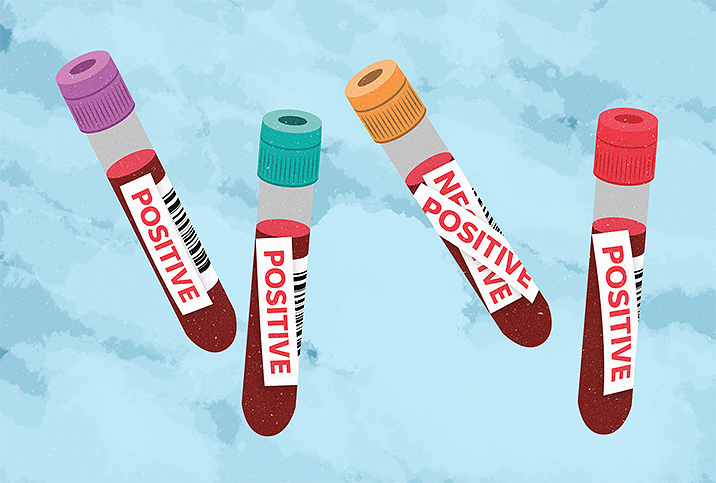False Positives in STI Testing Are More Common Than You Think

It's your turn in the party game of "Would you rather?": Following a screening for a sexually transmitted infection (STI), would you rather get a false negative or a false positive? The former allows for some short-term celebration followed by some potentially serious health issues; the latter provides an initial scare with a happy ending.
False positives in STI screening are rare, but rare doesn't mean nonexistent. Because of how certain infections act in the body, it's hard to design a test that is both fast and completely accurate all the time—as with any test or instrument in any industry, a false positive or negative can and does occasionally happen.
Technology is too sensitive
False positives may be the byproduct of advancing technology.
Nucleic acid amplification tests (NAATs) are extremely sensitive and represent a massive step forward in testing for all infections, not just STIs. In fact, NAATs have been used extensively during the past 18 months to test for SARS-CoV-2, the virus responsible for COVID-19.
NAATs work by pinpointing molecular information in a sample and amplifying, or copying, the specimen. Suddenly a trace amount of infection goes from undetected to found—it works like a molecular zoom-in tool. These tests can do wonders to prevent long-term illness, but their sensitivity can be a double-edged sword.
A 2018 Danish study recruited 272,105 women to screen for chlamydia and compared rates between NAAT and non-NAAT screenings. The risk for pelvic inflammatory disease (PID) as a result of long-term chlamydia between NAAT and less sensitive tests was the same for women who tested positive. However, the risk of PID following negative results from a non-NAAT test was higher than negative results from NAAT.
The scientists estimated that as many as 18 percent of chlamydia infections in patients tested with non-NAAT went undiagnosed. Considering the potentially fatal effects of untreated STIs, a false positive feels like an acceptable trade-off for increased detection, but anyone who tests positive should seek a further workup from their doctor and ask about their treatment path: overuse of antibiotics can lead to antibiotic-resistant strains of infection or superbugs.
Searching for Bigfoot

Adrienne Crowe, a certified nurse midwife (and the author's mother), said the most common false positive comes from rapid plasma reagin (RPR) tests, a blood test for antibodies to syphilis or the antibodies' reaction to syphilis.
"The test is valid but potentially flawed because it measures the body's response to the infection as opposed to the infection itself—it's like looking for Bigfoot and only finding huge footprints. Maybe you did find traces of Bigfoot, but maybe something else caused them," Crowe said. "If a woman's test comes back positive, we test again for titers or the concentrations of treponema—that's the bacteria causing syphilis."
In a 2015 study assessing the accuracy of RPR tests, 9,100 blood donors were screened for syphilis. Twenty tests came back positive. Upon additional testing, only eight of those positives were proven accurate. The study indicated a false-positive rate of 60 percent (12 out of 20), not dissimilar to the 56.4 percent rate in the field that the study also cited.
The Centers for Disease Control and Prevention (CDC) doesn't recommend testing asymptomatic patients for herpes, which seems counterintuitive until further inspection. Immunoglobulin tests (IgM) may mistake herpes simplex virus type 1 (HSV-1) for herpes simplex virus type 2 (HSV-2), the former being an orally transmitted infection causing cold sores and the latter causing genital herpes. A patient misdiagnosed with HSV-2 may experience greater stress, and isolation in social situations, and relationships, and may start taking antiviral medicines, which is problematic because antivirals may cause renal issues in some patients.
Test, and test again
False positives don't just ruin someone's day. A mistaken test that's not corrected could lead to waste as blood banks discard donations they believe to be infected.
Would you rather have a false negative or a false positive? Take the third option and play it safe with backup testing. A false negative may occur if you test too soon, because the infection may not be detectable yet. This is why certain healthcare providers advise patients with negative results to get retested in two weeks just to make sure.
Remember, not all tests are gold standards for diagnoses but rather just one ingredient contributing to a final treatment plan, which will be determined by you and your physician.


















